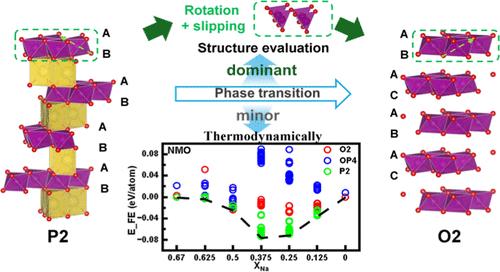通过原子计算了解P2-Na0.67Mn0.8M0.2O2阴极阳离子取代的热力学作用
IF 7
2区 材料科学
Q2 CHEMISTRY, PHYSICAL
引用次数: 0
摘要
p2型Na0.67MnO2阴极在循环过程中相变复杂,限制了其实际应用。本文采用第一性原理计算方法系统研究了Na0.67Mn0.8M0.2O2 (M0.2-NMO)中部分阳离子取代对热力学、结构演化和相变评价的影响。我们的研究结果表明,由于P2、OP4和O2相之间存在边际地层能量差异,阳离子取代对相变热力学驱动力的影响很小。然而,阳离子取代对结构相关因素(八面体畸变、键长畸变和剪切变形)以及MO6八面体旋转和层滑移引起的四面体过渡态的影响要大得多,这表明结构调节是提高相稳定性的更有效策略。我们对P2-to-O2转变的分析表明,Mg-和Co-NMO体系比纯NMO表现出明显更高的势垒,而几乎所有其他取代体系都导致滑动势垒增加。我们还研究了阳离子取代对脱氧过程中氧化还原机制的影响,并确定了高电荷状态下氧氧化还原的活化。总的来说,本研究提供了阳离子取代如何控制层状钠阴极的结构演变、相稳定性和电化学行为的机制见解,为高性能钠离子电池材料的合理设计提供了有价值的指导。本文章由计算机程序翻译,如有差异,请以英文原文为准。

Understanding the Thermodynamic Role of Cation Substitution in P2-Na0.67Mn0.8M0.2O2 Cathodes via Atomistic Calculations
P2-type Na0.67MnO2 cathodes suffer from complex phase transitions during cycling, limiting their practical application. In this work, first-principles calculations are employed to systematically investigate the effects of partial cation substitution in Na0.67Mn0.8M0.2O2 (M0.2-NMO) on thermodynamics, structural evolution, and phase transition evaluation. Our results reveal that cation substitution exerts only a minor influence on the thermodynamic driving forces of phase transitions owing to the marginal formation energy differences among the P2, OP4, and O2 phases. However, cation substitution has a much larger effect on structure-related factors (octahedral distortion, bond-length distortion, and shear deformation) and the tetrahedral transition states arising from MO6 octahedral rotations and layer slipping, suggesting that structure regulation is a more effective strategy for enhancing phase stability. Our analysis of the P2-to-O2 transition reveals that the Mg- and Co-NMO systems exhibit significantly higher barriers than pure NMO, whereas nearly all other substituted systems result in increased slipping barriers. We also investigate the effect of cation substitution on the redox mechanism during desodiation and identify the activation of oxygen redox at high states of charge. Overall, this study provides mechanistic insights into how cation substitution governs structural evolution, phase stability, and electrochemical behavior of layered sodium cathodes, offering valuable guidance for the rational design of high-performance sodium-ion battery materials.
求助全文
通过发布文献求助,成功后即可免费获取论文全文。
去求助
来源期刊

Chemistry of Materials
工程技术-材料科学:综合
CiteScore
14.10
自引率
5.80%
发文量
929
审稿时长
1.5 months
期刊介绍:
The journal Chemistry of Materials focuses on publishing original research at the intersection of materials science and chemistry. The studies published in the journal involve chemistry as a prominent component and explore topics such as the design, synthesis, characterization, processing, understanding, and application of functional or potentially functional materials. The journal covers various areas of interest, including inorganic and organic solid-state chemistry, nanomaterials, biomaterials, thin films and polymers, and composite/hybrid materials. The journal particularly seeks papers that highlight the creation or development of innovative materials with novel optical, electrical, magnetic, catalytic, or mechanical properties. It is essential that manuscripts on these topics have a primary focus on the chemistry of materials and represent a significant advancement compared to prior research. Before external reviews are sought, submitted manuscripts undergo a review process by a minimum of two editors to ensure their appropriateness for the journal and the presence of sufficient evidence of a significant advance that will be of broad interest to the materials chemistry community.
 求助内容:
求助内容: 应助结果提醒方式:
应助结果提醒方式:


